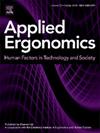汽车增强现实平视显示器的不透明性:用户偏好、视觉注意力和情况感知
IF 3.4
2区 工程技术
Q2 ENGINEERING, INDUSTRIAL
引用次数: 0
摘要
汽车增强现实抬头显示器(ar - hud)将驾驶信息叠加在外部视图上。然而,人们担心AR-HUD可能会分散注意力,并且关于如何最好地呈现AR-HUD图像的问题仍然存在。本研究探讨人们对AR-HUD不透明度的看法及其对驾驶员注意和态势感知的影响。创建驾驶场景视频,并添加不同不透明度的导航相关AR-HUD图像。27名参与者观看了这些视频,同时跟踪了他们的眼球运动。参与者回答了与AR-HUD图像的不透明性和他们的态势感知有关的问题。结果表明,驾驶员对AR-HUD不透明度的看法是矛盾的,不透明度影响人们对路边环境的观察和感知,20%和60%的不透明度水平都支持态势感知,并且AR-HUD不透明度对不同类型AR-HUD图像的影响是不同的。因此,AR-HUD的不透明程度需要进一步研究,以最大限度地提高驾驶安全性。本文章由计算机程序翻译,如有差异,请以英文原文为准。
Opacity in car augmented reality head-up displays: users’ preferences, visual attention, and situation awareness
Car augmented-reality heads-up displays (AR-HUDs) superimpose driving information on the outside view. However, there are concerns that AR-HUDs may be distracting and questions remain about how best to present AR-HUD imagery. This study explores people's opinions about AR-HUD opacity and its effects on driver attention and situation awareness. Videos of driving scenes were created and navigation-related AR-HUD imagery was added at different opacity levels. Twenty-seven participants watched these videos while their eye movements were tracked. Participants answered questions related to the opacity of the AR-HUD imagery and to their situation awareness. Results suggest that drivers are ambivalent about AR-HUD opacity, opacity affects how people look at and perceive the roadside environment, opacity levels of 20 % and 60 % both support situation awareness, and the effects of AR-HUD opacity are different for different types of AR-HUD imagery. Thus, AR-HUD opacity levels need to be further investigated to maximize driving safety.
求助全文
通过发布文献求助,成功后即可免费获取论文全文。
去求助
来源期刊

Applied Ergonomics
工程技术-工程:工业
CiteScore
7.50
自引率
9.40%
发文量
248
审稿时长
53 days
期刊介绍:
Applied Ergonomics is aimed at ergonomists and all those interested in applying ergonomics/human factors in the design, planning and management of technical and social systems at work or leisure. Readership is truly international with subscribers in over 50 countries. Professionals for whom Applied Ergonomics is of interest include: ergonomists, designers, industrial engineers, health and safety specialists, systems engineers, design engineers, organizational psychologists, occupational health specialists and human-computer interaction specialists.
 求助内容:
求助内容: 应助结果提醒方式:
应助结果提醒方式:


